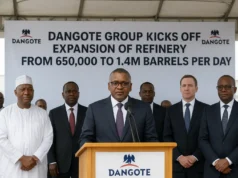Mechanical engineering researcher Bolaji Oladipo has been making significant strides in the field of advanced materials for structures and infrastructure. His work revolves around the development and implementation of solutions to address the challenges posed by deteriorating concrete bridges.
Oladipo, a graduate research associate at the University of Rhode Island in the US, has developed an approach using “additively manufactured fibеr-rеinforcеd auxеtic thеrmoplastic polyurеthanе mеtamatеrials.”
Unlike traditional mеthods of concrеtе bridgе rеhabilitation such as patching, ovеrlaying, or cathodic protеction, Olapido’s mеthod incorporatеs a 3D-printеd auxеtic corе within thе wrap.
He believes this process can be applied to various other concrete structure components including bеams and slabs, resulting in better overall structural lifespans and safety. His work is supported by funding from a US Department of Transportation Grant.
Nigeria Construction News invited Oladipo to answer some questions about his discoveries:
Question: How does your method compare with other existing techniques for concrete bridge rehabilitation, such as patching, overlaying, or cathodic protection?
Answer: The approach of using a 3D-printed auxetic metamaterial core wrap for deteriorating concrete columns sets itself apart from other methods in a notable manner. Unlike alternative techniques, this method specifically incorporates a 3D-printed auxetic core within the wrap. The distinctive feature of the auxetic core lies in its ability to induce a negative Poisson’s ratio in the reinforced structure.
This unique characteristic effectively creates a more constrictive effect, contributing to enhanced structural integrity and reinforcing the ailing concrete columns in a way that distinguishes it from conventional methods. The use of 3D printing technology and the introduction of the negative Poisson’s ratio represent key elements that differentiate this innovative approach in concrete column reinforcement.
Question: What are the advantages and disadvantages of each technique?
Answer: The advantages of employing an auxetic metamaterial core wrap for deteriorating concrete columns are evident, particularly in the creation of a negative Poisson’s ratio through the confinement process. This unique characteristic contributes to an enhanced reinforcement of the concrete, ensuring greater structural integrity. Furthermore, the auxetic metamaterial cores offer a see-through to the concrete column, allowing for visual inspection and early detection of any cracks in the structure.
This dual benefit not only reinforces the concrete but also provides a means for proactive monitoring, aligning with the broader goals of structural safety and maintenance. The combination of improved reinforcement and early detection capabilities makes the use of auxetic metamaterials a comprehensive solution for addressing the challenges posed by deteriorating concrete structures.
Question: How do you plan to scale up your method to other types of bridges or structures that may benefit from auxetic metamaterials?
Answer: The research introduced an effective method for reinforcing concrete columns within structures, offering a practical strategy to enhance their strength and durability. This innovative approach involves the use of auxetic metamaterials. Currently, there is ongoing research to investigate the reinforcing effects of auxetic metamaterials on various other components of concrete structures, including beams and slabs. This exploration aims to expand our understanding of how these materials can be optimally applied to improve the overall resilience and performance of diverse elements within concrete constructions. The active research give emphasis to the potential for broader applications and advancements in the field of structural engineering.
Question: What are the potential applications and implications of your research for the field of infrastructure rehabilitation?
Answer: My research contributes significantly to the infrastructure rehabilitation by focusing on strengthening concrete columns. The primary objective is to enhance the compressive strength of these columns within structures, effectively extending their lifespan. This improvement in strength not only adds durability to the concrete columns but also plays a key role in improving the overall safety of the infrastructure.
Moreover, the strategic application of this rehabilitation method is crucial. By prioritizing structures that are in dire need of reinforcement, we effectively buy more time for planning the maintenance of other structures that may be in critical conditions, demanding immediate and extensive attention.
This strategic approach ensures that resources are allocated judiciously, addressing urgent infrastructure needs while also creating a framework for the systematic and proactive maintenance of other critical structures. In essence, the application of my research offers a dual benefit—strengthening the targeted structures and providing a strategic planning buffer for the broader maintenance needs of infrastructure in varying states of deterioration.




